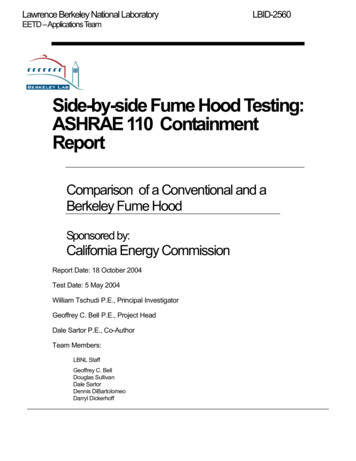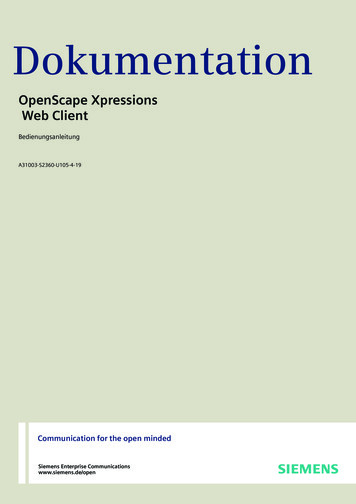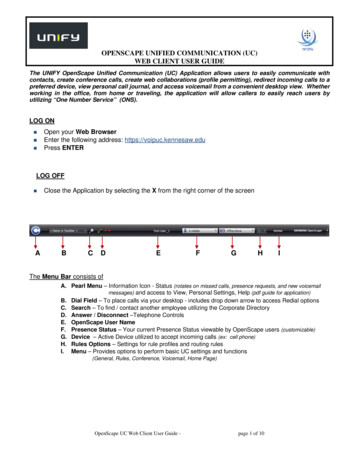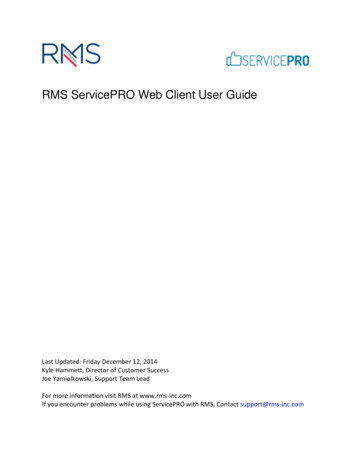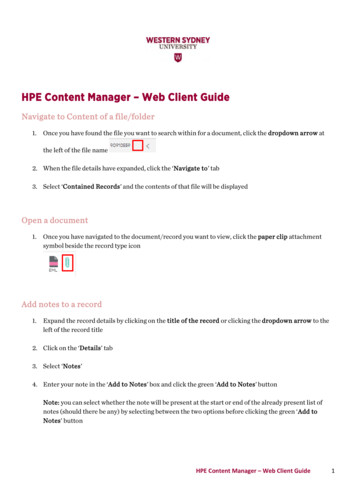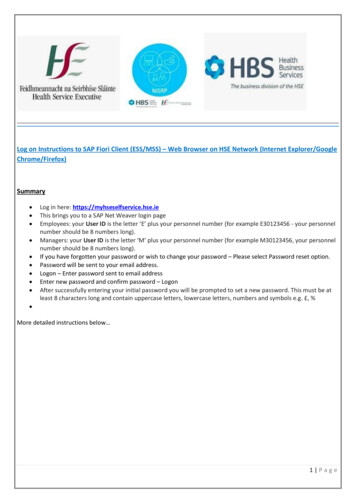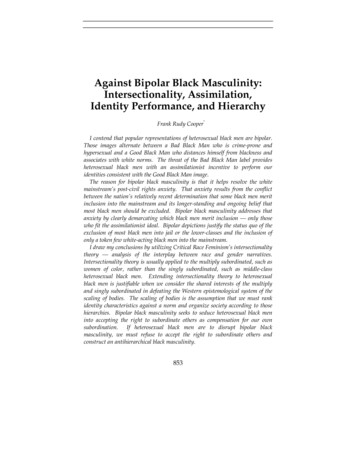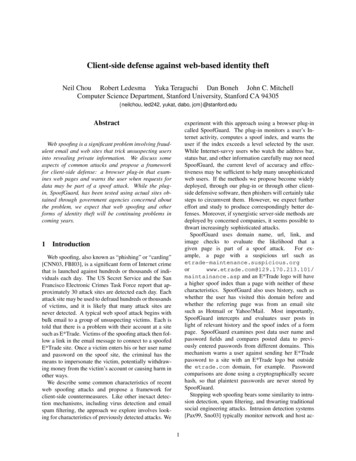
Transcription
Client-side defense against web-based identity theftNeil Chou Robert Ledesma Yuka Teraguchi Dan Boneh John C. MitchellComputer Science Department, Stanford University, Stanford CA 94305{neilchou, led242, yukat, dabo, jcm}@stanford.eduAbstractexperiment with this approach using a browser plug-incalled SpoofGuard. The plug-in monitors a user’s Internet activity, computes a spoof index, and warns theuser if the index exceeds a level selected by the user.While Internet-savvy users who watch the address bar,status bar, and other information carefully may not needSpoofGuard, the current level of accuracy and effectiveness may be sufficient to help many unsophisticatedweb users. If the methods we propose become widelydeployed, through our plug-in or through other clientside defensive software, then phishers will certainly takesteps to circumvent them. However, we expect furthereffort and study to produce correspondingly better defenses. Moreover, if synergistic server-side methods aredeployed by concerned companies, it seems possible tothwart increasingly sophisticated attacks.SpoofGuard uses domain name, url, link, andimage checks to evaluate the likelihood that agiven page is part of a spoof attack.For example, a page with a suspicious url such m@129.170.213.101/maintainance.asp and an E*Trade logo will havea higher spoof index than a page with neither of thesecharacteristics. SpoofGuard also uses history, such aswhether the user has visited this domain before andwhether the referring page was from an email sitesuch as Hotmail or Yahoo!Mail. Most importantly,SpoofGuard intercepts and evaluates user posts inlight of relevant history and the spoof index of a formpage. SpoofGuard examines post data user name andpassword fields and compares posted data to previously entered passwords from different domains. Thismechanism warns a user against sending her E*Tradepassword to a site with an E*Trade logo but outsidethe etrade.com domain, for example. Passwordcomparisons are done using a cryptographically securehash, so that plaintext passwords are never stored bySpoofGuard.Stopping web spoofing bears some similarity to intrusion detection, spam filtering, and thwarting traditionalsocial engineering attacks. Intrusion detection systems[Pax99, Sno03] typically monitor network and host ac-Web spoofing is a significant problem involving fraudulent email and web sites that trick unsuspecting usersinto revealing private information. We discuss someaspects of common attacks and propose a frameworkfor client-side defense: a browser plug-in that examines web pages and warns the user when requests fordata may be part of a spoof attack. While the plugin, SpoofGuard, has been tested using actual sites obtained through government agencies concerned aboutthe problem, we expect that web spoofing and otherforms of identity theft will be continuing problems incoming years.1IntroductionWeb spoofing, also known as “phishing” or “carding”[CNN03, FBI03], is a significant form of Internet crimethat is launched against hundreds or thousands of individuals each day. The US Secret Service and the SanFrancisco Electronic Crimes Task Force report that approximately 30 attack sites are detected each day. Eachattack site may be used to defraud hundreds or thousandsof victims, and it is likely that many attack sites arenever detected. A typical web spoof attack begins withbulk email to a group of unsuspecting victims. Each istold that there is a problem with their account at a sitesuch as E*Trade. Victims of the spoofing attack then follow a link in the email message to connect to a spoofedE*Trade site. Once a victim enters his or her user nameand password on the spoof site, the criminal has themeans to impersonate the victim, potentially withdrawing money from the victim’s account or causing harm inother ways.We describe some common characteristics of recentweb spoofing attacks and propose a framework forclient-side countermeasures. Like other inexact detection mechanisms, including virus detection and emailspam filtering, the approach we explore involves looking for characteristics of previously detected attacks. We1
tivity, compute statistical or other indices, and attemptto detect intrusions by comparing the index of currentactivity against previous statistics. While web spoofingmay be regarded as a special case of intrusion detection,the browser seems like that appropriate place to combatweb spoofing. A browser plug-in is relatively easy to install and has access to honest and spoof pages sent overhttps, giving SpoofGuard a better chance of catching anattack than a network proxy or other external http trafficmonitors. While a plug-in alone does not have full information from email programs such as Outlook or Eudorathat may contain the messages that launch an attack, thebrowser does provide an indication of the referring pageor application, and it is possible to scan and parse pagesfrom email sites such as Hotmail or Yahoo!Mail. Therefore, for non-expert users who read email through theirbrowser, SpoofGuard has the potential to examine everystep of a standard web spoof attack.Like other intrusion detection efforts, it is appropriateto evaluate SpoofGuard by measuring its effective at preventing attacks, the false alarm rate (number of unnecessary warnings), and its performance impact. SpoofGuard will only be useful if it detects attacks withoutraising too many false alarms, since users will almostcertainly reject any method that interferes with normalbrowsing activity. We have evaluated the false-alarmrate by using SpoofGuard ourselves over a period oftime, and we have evaluated its effectiveness for preventing attacks using actual spoof sites brought to ourattention by members of the San Francisco ElectronicCrimes Task Force. While this is not an extensiveenough test to draw broader conclusions, SpoofGuarddoes catch the sample attacks found in the wild and doesnot add any noticeable delay to ordinary web browsing.Since web spoofing attacks begin with bulk email, agood general spam solution [Bri03, Din03] could reducethe incidence of web spoofing attacks. However, currentspam solutions are only partly effective at blocking unwanted email, and we are not aware of any spam effortsaimed specifically at identify theft. While the browserbased techniques we explore in this paper are complementary and independent of spam filtering, there may beadditional ways of combining email scanning with webpage analysis that will lead to better spoof prevention inthe future.Previous efforts by the Princeton Secure Internet Programming group and others [FBDW97, EY01] have addressed another form of “web spoofing” in which anattacker causes all html page requests from a victimto pass through the attacker’s site. This form of webspoofing allows the attacker to monitor all of the victim’s activities, including posted passwords or accountnumbers. However, previous methods for counteringthis form of attack have focused on maintaining the in-tegrity of browser indicators such as the url indicator inthe status bar, not analyzing user behavior, web pages,and html post data to stop leakage of sensitive user information. While we considered using an alternate termsuch as “phishing” in this paper, we use “web spoofing”since this currently appears to be the term most commonly used by law enforcement and concerned companies.The goals of this paper are to raise awareness of theweb spoofing problem and propose a framework forclient-side protection. While sophisticated and determined attackers will be able to circumvent our currenttests (through simple techniques we explain later in thepaper), there is plenty of room for improving specifictests and tuning the coefficients of our spoof index function. Furthermore, the web spoofing problem is important and we believe our SpoofGuard experience will beuseful for developing more sophisticated defenses. Wediscuss the web spoofing problem in more detail in Section 2, and our solutions in Section 3. The SpoofGuardimplementation and user interface are described in Section 4. Some SpoofGuard evaluation information appears in Section 5, followed by suggestions for serverside methods in Section 6, some more speculative clientside methods in Section 7, and concluding remarks inSection 8.Throughout the paper we use the following terminology. Spoof site or Spoof page: the site or page that is amalicious copy of some legitimate web page. Attacker: the person or organization who sets upthe spoof site. Honest site or honest page: the legitimate site orpage that is being spoofed. Spoof index: a measure of the likelihood that a specific page is part of a spoof attack, described in Section 3.A prototype version of SpoofGuard will be made publicly available shortly.2 The problemAccording to Agents of the U.S. Secret Service SanFrancisco Electronic Crimes Task Force [Von03], theU.S. Government’s Internet Fraud Complaint Center received over 75,000 complaints in 2002. Of this number,48,000 cases resulted in further action requests. This isa three-fold increase over 2001. The total dollar lossesare estimated at more than 54 million compared to 17million for 2001. A majority of these fraud complaintsare intrusions, auction fraud, credit card/debit fraud, andcomputer intrusion. Agents of the U.S. Secret ServiceSan Francisco Electronic Crimes Task Force report thatweb spoofing was first noticed in late 2001 and grew in2
popularity in 2002, correlating with the large increase inInternet Fraud. Further, a majority of the 37 millionincrease in losses from 2001 to 2002 can be attributedto web spoofing. Agents working fraud cases in the BayArea also report that a majority of their Internet casesinvolve web spoofing.One factor that adds to the severity of web spoofingattacks is that many users use the same username andpassword at several sites. This allows a phisher whoreels in a victim to use this information on more than onesite. For this reason, companies that provide passwordprotected services are dependent on each other for theirsecurity. This is not only true with regard to web spoofing, but for other kinds of attacks as well. If passwordsfrom one site can be stolen by attacking the site itself,these may also be used at other sites that protect theirpassword database more effectively.2.1gan Stanley’s Discover unit, eBay Inc. and its PayPal unit, Wachovia Corp.’s First Union unit and theMassachusetts State Lottery reported phishing scams inrecent months. Some general information about webspoofing, including additional news articles and recordsof actual attacks, may be found at http://www.antiphishing.org/, a web site provided by Tumbleweed Communications.2.2Properties of recent attacksWe describe common properties of ten spoof web sitesrecently found in the wild. Figure 4 gives an example ofan Ebay spoof (partially obscured by a SpoofGuard popup warning the user). Logos. The spoof site uses logos found on the honest site to imitate its appearance. Suspicious urls.Spoof sites are located onservers that have no relationship with the honest site.The spoof site’s url may containthe honest site’s url as a substring (http://www.ebaymode.com), or may be similar to the honest url (http://www.paypaI.com). IP addresses are sometimes used to disguise the host name (http://25255255255/top.htm).Others use @ marks to obscure their host names (http://ebay.com:top@255255255255/top.html), or containsuspicious usernames in their urls (http://middleman/http://www.ebay.com.) User input. All spoof sites contain messages to foolthe user into entering sensitive information, such aspassword, social security number, etc. Some successful spoofs have even been so bold as to ask forname, address, mother’s maiden name, driver’s license, and so on. Short lived. Most spoof sites are available for onlya few hours or days – just enough time for the attacker to spoof a high enough number of users. Theimplication is that defensive methods that alert theuser to a spoof site are more effective than reactivemethods that attempt to shutdown the site. Copies. Attackers copy html from the honest siteand make minimal changes. Two consequencesare: (i) some spoof pages actually contain links toimages (e.g. logos and buttons) on the honest site,rather than storing copies, (ii) the names of fieldsand html code remain as on the honest site. Wenote that when a spoof site refers to the honest sitefor embedded images it gives the honest site an opportunity to detect the spoof: the honest site detectsan http request for an embedded image where thereferral header is not the honest site. Such requestsshould not occur unless the honest site is being plagiarized.Sample attackA recent attack described in a New York Times article [HF03] actually mentioned fraudulent email, indicating some level of public awareness of spoof attacks.On June 18, 2003, thousands of fraudulent e-mails withthe subject “Fraud Alert” were sent out, hoping to reachBest Buy customers. The e-mails attempted to convince customers that Best Buy’s fraud department required additional customer information, “in our effort todeter fraudulent transactions.” To further lure unsuspecting victims, the e-mail provided a link that purportedto reach a “special Fraud Department” at the Best Buyweb site. Instead, the link actually pointed to a fraudulent page unrelated to Best Buy. The Best Buy attacker’spage resembled an official Best Buy page, using the BestBuy logo, incorporating elements from an official BestBuy page, and providing links to other Best Buy resources. The page requested a customer’s social securitynumber and credit card information.A web page from the Michigan Attorney General[Cox03] cites “a few giveaways to this particular scam:” The [email] message did not issue from an@bestbuy.com address, The link embedded in the message does nottake the user to a “special Fraud Department page” on Best Buy’s site, but to apage hosted under a completely different domain name (such as digitalgamma.com oryour-instant-credit-reporter.org), The “National Credit Bureau” mentioned in thescam does not exist.The Michigan Attorney General also points out thatthe Best Buy spoof is similar to spoofs imitating PayPal and eBay. A more recent Dow Jones Newswiresstory [Ber03] states that EarthLink, Citibank, Mor3
Sloppiness or lack of familiarity with English.Many spoof pages have silly misspellings, grammatical errors, and inconsistencies. In the Best Buyscam, the fake web page listed a telephone numberwith a Seattle area code for a Staten Island, NY,mailing address. HTTPS is uncommon. Most spoof web sites do notuse https even if the honest site does. This simplifies setting up the spoof site.3commonly used in intrusion detection systems and spamfilters [Din03].The scoring function not only sums individual tests,but also sums products of pairs, triples, and larger subsets of tests. The reason for product terms is that whencertain combinations of events occur the likelihood ofthe page being a spoof increases dramatically. For example, if a company logo appears on an unauthorized pageand the page contains password and creditcard fields, thepage is very likely to be a spoof. Consequently, the termcorresponding to the product of these three tests is givensubstantial weight.SolutionsA number of tests can be used to distinguish spoofpages from honest pages. We present the tests we implemented and evaluated in three groups: stateless methods that determine whether a downloaded page is suspicious, stateful methods that evaluate a downloaded pagein light of previous user activity, and methods that evaluate outgoing html post data. Our browser plug-in applies these tests to all downloaded pages and combinesthe results using a scoring mechanism described below.The total spoof index of a page determines whether theplug-in alerts the user and determines the severity andtype of alert. Since pop-up warnings are intrusive andannoying, we attempt to warn the user through a passivetoolbar indicator in most situations. A user checkboxcan eliminate all pop-ups if desired.We note that server-side methods, such as trackingserver image requests, may also be effective in identifying spoof sites. However, the focus of this paper is onclient-side browser solutions. In section 6, we commenton some ways that server-side modifications may makeour client-side methods more reliable and effective.3.13.2Stateless page evaluationWe begin by describing a collection of tests that workby examining the current page only.Url check There are various methods that attackerscan use to produce misleading urls. For example, an@ in a url causes the string to the left to be disregarded,with the string on the right treated as the actual url forretrieving the page. Combined with the limited size ofthe browser address bar, this makes it possible to writeurls that appear legitimate within the address bar, butactually cause the browser to retrieve a page from an arbitrary site.Image check Spoof sites usually contain images takenfrom the honest site. For example, the eBay logo appears on spoofed eBay pages to give the user the impression that they are communicating with eBay. If theeBay logo appears on a login page unrelated to eBay,that page is suspicious. The same applies to other identifiably eBay-specific images such as banners and buttons. We note that corporate logos often legitimately appear on many e-commerce sites (e.g., the Amazon logoappears on sites that sell products through Amazon) andtherefore we only count this test for pages that ask forprivate user input.In order to apply this check in a stateless way, theSpoofGuard plug-in is supplied with a fixed database ofimages and their associated domains. Since attackersgenerally do not have email lists for customers of specific sites, they must try to spoof sites that are used by asignificant fraction of web users. Thus SpoofGuard canbe useful even if we only account for relatively smallnumber of frequently spoofed domains such as eBay,PayPal, AOL, and so on. When the browser downloadsa login page all images on the page are compared to images in the SpoofGuard database. The spoof-score forthe page is increased if a match is found but the page’sdomain is not a valid domain for the image.What if the spoof page contains a slight modificationScoringGiven a downloaded web page and some browser stateas input, our plug-in applies tests T1 , . . . , Tn , with testTi producing a number Pi in the range [0, 1]. By convention, Pi 1 indicates that the page is likely to be aspoof and Pi 0 indicates the opposite. Most of ourtests return either 0 or 1, but some can return a valuebetween 0 and 1.We combine the test results into a total spoof score,T SS, using a standard aggregation function:PnT SS(page) Pi 1 wi Pin wi,j Pi PjPi,j 1n i,j,k 1 wi,j,k Pi Pj Pk .The w’s are preset weights selected to minimize the falsealarm rate. Note that most of the w’s are set to zero sothat the actual number of terms in the expression is relatively small. This approach of applying multiple testsand combining the results using a scoring mechanism is4
of the real image? The image comparison test might failto detect the spoof. Fortunately, as noted earlier, attackers often directly copy or link to images on the honestsite. Nevertheless, we defend against small image modification by storing an image hash rather than the actual image. Image hashing refers to a hashing algorithmthat produces the same hash for similar images. Whilepresent technology does not provide ideal image hashes,there has been some progress in this area [VKJM00]. Inour case, image hashing can be strengthened by askinge-commerce sites to use images that are especially wellsuited for image hashing. For example, in many caseswe could use optical character recognition (OCR) as theimage hashing algorithm. An added benefit of imagehashing is th
the etrade.com domain, for example. Password comparisons are done using a cryptographically secure hash, so that plaintext passwords are never stored by SpoofGuard. Stopping web spoofing bears some similarity to intru-sion detection, spam filtering, and thwarting traditional social engineering attacks. Intrusion detection systems
